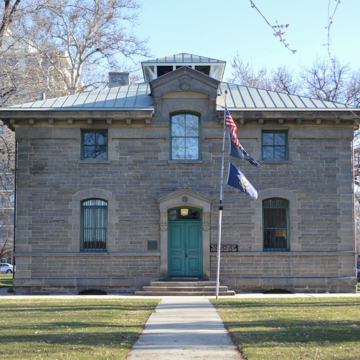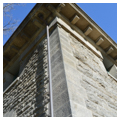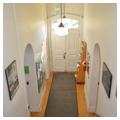The Assay Office, located on the edge of Boise’s downtown core, embodies the early importance of the mining industry in Idaho and the federal government’s commitment to the fledgling Idaho Territory. Built shortly after the early construction boom in the territorial capital, the Assay Office helped to bring a sense of permanence and stability to the frontier town of Boise City. The Assay Office sits alone, in the center of an entire city block, communicating its importance through its design, materials, and setting. In terms of its proportions and massing, the two-story stone building bridges between residential and institutional scales.
In the 1860s, after gold and silver lodes were discovered in the Clearwater Valley of what is now northern Idaho, miners and speculators flooded into the region. By 1863, the subsequent discovery of rich ores in the Boise Basin and what became Silver City had spurred a significant population boom and prompted President Lincoln to create the Idaho Territory, thereby strategically securing the resources for the federal government’s cause. By the mid-1860s, almost 20 percent of the nation’s gold was coming from the Territory, but transportation to the nearest mint in San Francisco was difficult and shipping costs were high. Miners and businessmen began to lobby for a federal facility to be established in the area; in 1869 they were successful, and Congress appropriated $75,000 for an Assay Office to be built in Boise.
Anxious for construction to proceed, prominent Boisean Alexander Rossi effectively donated the land for the building—selling Block 35 in Boise to the government for the sum of one dollar. The site, though outside of Boise’s original plat of 1863, was located well within the city’s expanded plat of 1867. A square block of desert scrub at the time, historic photos show that it was quickly planted with lush grass and copious shade trees. The 48 x 46–foot building, constructed in 1871, is sited in the middle of its full block lot, projecting a quiet strength and formal dignity. The Assay Office’s relationship to its site was and continues to be an aberration from surrounding development patterns; the residential neighborhood that historically grew up around it featured largely single-family houses sited on narrow lots with consistent setbacks. In recent decades a majority of neighborhood blocks have been redeveloped to include single commercial structures surrounded by asphalt parking lots.
Alfred B. Mullett, Supervising Architect of the U.S. Treasury, designed the building with characteristics of the Italianate style though without heavy ornamentation. Requiring a secure and fortified structure, but desiring a distinguished and imposing piece of architecture, Mullett adapted the Italianate for use of native Boise sandstone, an unusual material for the style. The smooth, ashlar quoins stand in contrast to the rusticated stone on the body of the building. This stone distinguishes the building since the Italianate style is more typically rendered in lighter materials, like wood or brick, and residential examples most often have delicate, decorative woodwork as an obvious visual element. The Assay Office lacks the pretentions of the residential variant of the style, but upon closer examination, many of the hallmarks of Italianate design are readily apparent: square massing; a hipped roof with cupola; wide-projecting eaves with decorative brackets; arched windows; and a paneled, double-door, all reflect elements of this style, popular in the U.S. from 1840 to 1880.
The Assay Office building has two stories and a basement. As originally designed, the first floor housed the Office of the Chief Assayer and two other offices, a laboratory, two vaults, and a clear-story that extended from the basement through the first story to accommodate the smelting furnaces used in metal purification assessment. The basement held another vault, storage rooms, a bathroom, and two rooms for a guard to live on-site, ensuring that the building and the minerals within were protected twenty-four hours a day.
As a frontier outpost of the federal government, the building also supplied living quarters for the Chief Assayer and his family. The entire second floor of the Assay Office building contained a three-bedroom apartment with a living room, dining room, kitchen, and bathroom. Historic photos provide insight into this residential aspect of the property, showing families tending vegetable and flower gardens and at one point near the turn of the century, a small structure standing adjacent to the stone building. This was likely a summer kitchen or screened room to provide outdoor living space, since the primary structure lacked a porch, a very popular residential element at the time.
Almost as soon as the building opened to receive ore in 1872, the initial boom of surface discoveries had begun to slow. The mines in Idaho Territory (and from 1890, the State of Idaho) continued to produce valuable metals, but never in the heady amounts of that first decade. By the 1930s, production from the Idaho mines had diminished considerably. Meanwhile, transportation networks improved and shipping costs decreased significantly; it was no longer necessary or efficient for the Treasury Department to operate a facility in Idaho. In 1933, the Assay Office building was turned over to the United States Forest Service (USFS) for use as the headquarters of the Boise National Forest.
The USFS remodeled the building immediately, retaining the basic floorplan, but removing the smelter and converting the second-story apartment to office space. They removed the bars from the windows (these have since been restored) and the three vaults became simple closets. Additionally, three of the large chimneys were removed, and where there were previously no windows on the back of the building, the USFS added several. The building continued to house the Boise National Forest offices until the 1970s when they outgrew the space and turned it over to the Idaho State Historical Society. Since then, it has housed various offices of that agency, primarily the State Historic Preservation Office.
In 1966, the Assay Office was designated a National Historic Landmark, citing the building’s importance as a piece of public architecture, and as the focal point for national and state interests in the mining industry in Idaho.
References
Rossi, Alexander. Quit claim deed to the United States Government. July 8, 1869.
Snell, Charles W. Historic Sites Survey Reports. Boise, ID: National Park Service, 1963–1964.
U.S. Congress, Senate Committee on Finance. Memorial of the Legislative Assembly of Idaho, praying an appropriation for the construction of an assay office at Boise City in that Territory. December 22, 1868. Washington: n.p., 1869.














